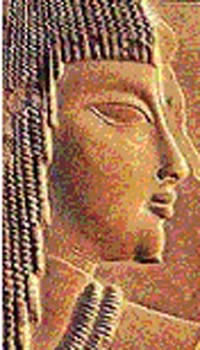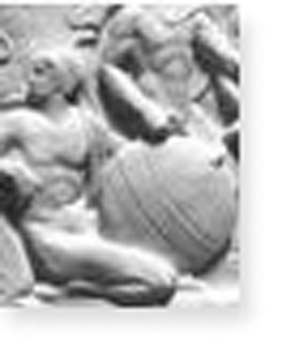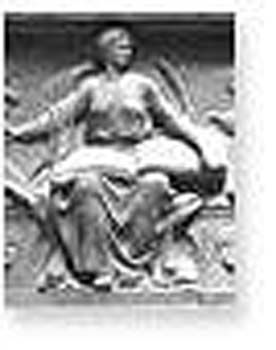 The oldest traces of plaster are 9.000 years old and were found in Anatolia and Syria. It is also known that 5.000 years ago, the Egyptians used to burn gypsum in open-air fires and then crush it into powder, which was mixed with water and used as an adhesive in the construction of their monuments, such as the magnificent Cheops Pyramid. The ancient Egyptians also used gypsum to form molds directly from the human body. The oldest traces of plaster are 9.000 years old and were found in Anatolia and Syria. It is also known that 5.000 years ago, the Egyptians used to burn gypsum in open-air fires and then crush it into powder, which was mixed with water and used as an adhesive in the construction of their monuments, such as the magnificent Cheops Pyramid. The ancient Egyptians also used gypsum to form molds directly from the human body.
The ancient Greeks used gypsum in many applications, such as in the construction of statues and windows of temples; in that period, gypsum was used in a transparent form (selenite). The writer Theophraste (372-287 B.C.) described in his works the production of plaster in details as it was done during that time in Syria and Phoenicia.
In ancient Rome, it was found that Romans had built thousands of copies of Greek statues using plaster molds.
In the early 18th century, in Paris, the walls of wooden houses were covered with plaster, as a protection against fire. The King of France had enforced this rule after the Great London Fire literally destroyed the city in 1666. Given the above fact, the plaster was given the name “Plaster of Paris”.
Today, gypsum is widely used in many applications in our daily lives and in different sectors, such as construction materials, health, agriculture, decoration etc.
|
 |
Gypsum, a sedimentary rock (scientifically named "Calcium Sulfate"), is created from the evaporation of sea water that is trapped in lagoons of subsoil and is usually found in mountains. The impure gypsum, which is found in the subsoil, can have different colour variations, such as grey, brown or red. However, the pure plaster colour is white.
Gypsum Plaster is produced after a thermal treatment (130-170 oC) of the natural gypsum (CaSO4· 2H2Ο), which is dehydrated partially in order to produce a hemi-hydrate substance (CaSO4· ½ H2Ο). The chemical equation is:
(CaSO4· 2H2O) + heat = (CaSO4· ½ H2O) + 1½ H2O
GENERAL USES
Gypsum is suitable for all interior plasterworks and moldings, except in areas directly exposed to water or severe moisture. It is therefore not recommended for exterior applications. Gypsum is also non-combustible and fire-resistant during extended periods of time. A short description of various applications of our products can be found below:
Plaster of Paris
Due to its dazzling whiteness and excellent properties, such as slow final setting time (40 min), Plaster of Paris is suitable for the creation of gypsum statuettes and decorations, with remarkable final results.
Ceramic Plaster
This type of plaster is used particularly in the formation of molds, due to their long-lasting durability that allows multiple castings.
Building Plaster
Ultra-white plaster with fast final setting time. This product is suitable for the construction industry, where it provides easy and smooth application for stuccoworks, is an excellent adhesive for plasterboards and moldings, can be used in mixtures with other materials, or as a supplementary material in paintworks.
Building Plaster is also used as an adhesive in the marble industry, contributing effectively during the cutting and arrangement of marble pieces.
Hydrated Gyspum
Hydrated gypsum is mainly targeted at agriculture for the desalination of pathogen and saline terrains, as well as to the production of mixtures, mortars and similar building materials. Due to its property to decrease the acidic pH, it is used in the agricultural food industry, such as sugar and mushroom processing. Hydrated gypsum is also used in the health industry for the production of certain medicines and in the castings of dentures.
Natural Gypsum
Crushed into 30 cm rocks, natural gypsum is targeted exclusively at the cement industry. |
|




 The oldest traces of plaster are 9.000 years old and were found in Anatolia and Syria. It is also known that 5.000 years ago, the Egyptians used to burn gypsum in open-air fires and then crush it into powder, which was mixed with water and used as an adhesive in the construction of their monuments, such as the magnificent Cheops Pyramid. The ancient Egyptians also used gypsum to form molds directly from the human body.
The oldest traces of plaster are 9.000 years old and were found in Anatolia and Syria. It is also known that 5.000 years ago, the Egyptians used to burn gypsum in open-air fires and then crush it into powder, which was mixed with water and used as an adhesive in the construction of their monuments, such as the magnificent Cheops Pyramid. The ancient Egyptians also used gypsum to form molds directly from the human body.